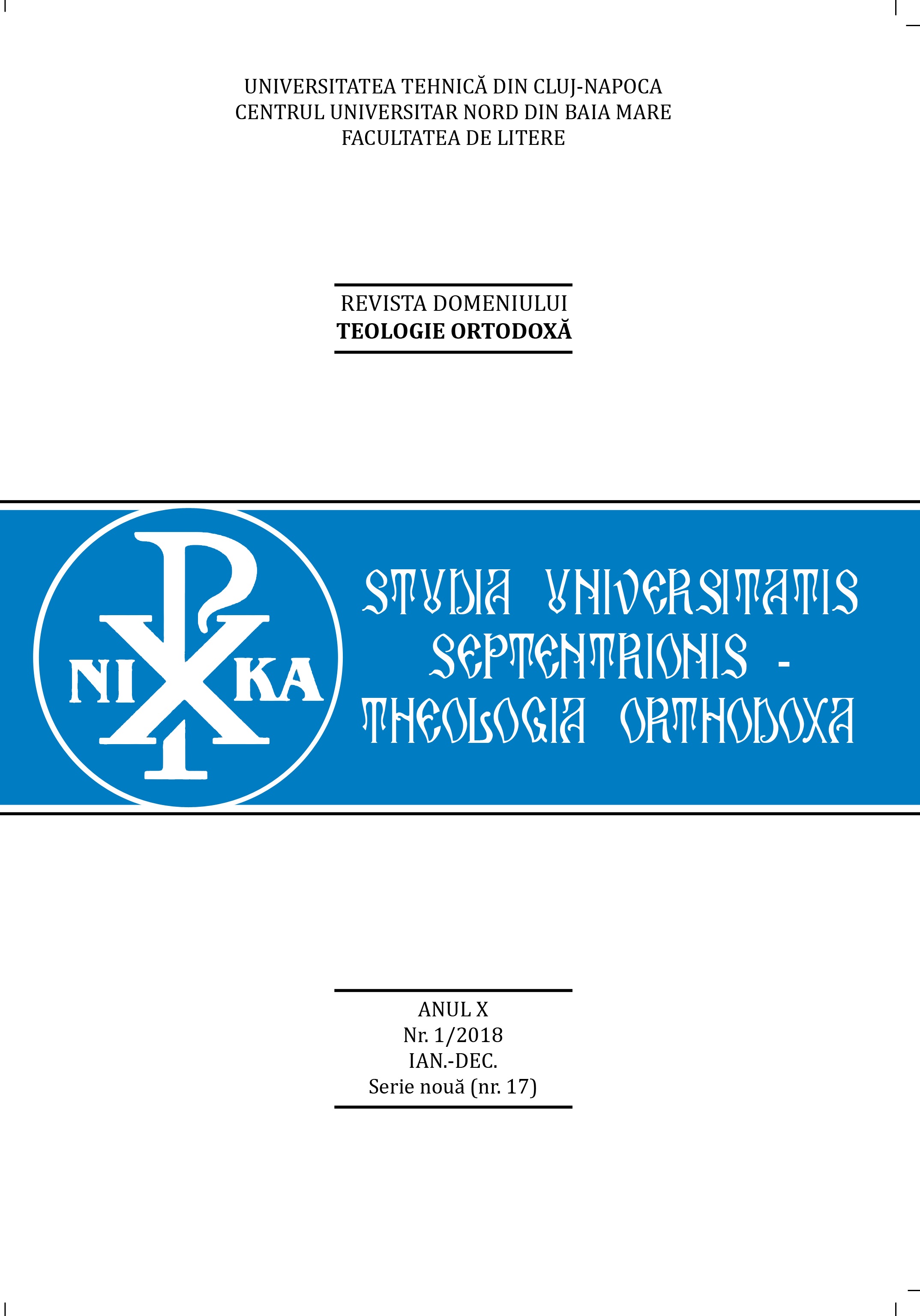
We kindly inform you that, as long as the subject affiliation of our 300.000+ articles is in progress, you might get unsufficient or no results on your third level or second level search. In this case, please broaden your search criteria.



Lineage and orthodoxy are primary components in the essence of Romania. These items depict the fact that religious concern occupied an essential place in its people's soul. That is the reason why the Romanian people have always prayed and talked to God in the tongue of their christened Dacian-Roman forefathers. When the Slavonic language, out of political reasons, had tried to impose in administration and Church worship, the Church Ministers, noticing this anomaly, managed to reinstate the Romanian ways via translations, printing activities and Orthodox worship. Starting with Coresi in Transylvania (in the 16th century), Metropolitan Simion Ștefan from Alba Iulia, the New Testament from 1648, with Varlaam, the Metropolitan of Moldavia, and his book „Romanian Book of Learning” (also known as „Cazania of Varlaam”) from 1643 and many others, with the vast printing activity of Metropolitan Dosoftei and culminating with The Bucharest Bible from 1688, the peak of Romanian religious literature. All these, and many others, established in a permanent frame Romania's national language unity.For several centuries the formation of Romania’s literary language has been associated with a work of art due to the translation of the Bible, and its translators, and to the most distinguished scribes the Romanian territory could offer.
More...
In the context of a BBC documentary comparing various religions of the world, the Romanian paradigm appears as a surprising choice among the great cultures of America, India, Africa, Japan etc. Furthermore, it is even more impressive that it highly influenced the spiritual evolution of the British journalist Ronald Eyre. The essence of this experience is placed in the land of Maramureş and it is connected to the name of Justinian, the unique bishop who seems to have descended from the live icon of eastern Christianity.
More...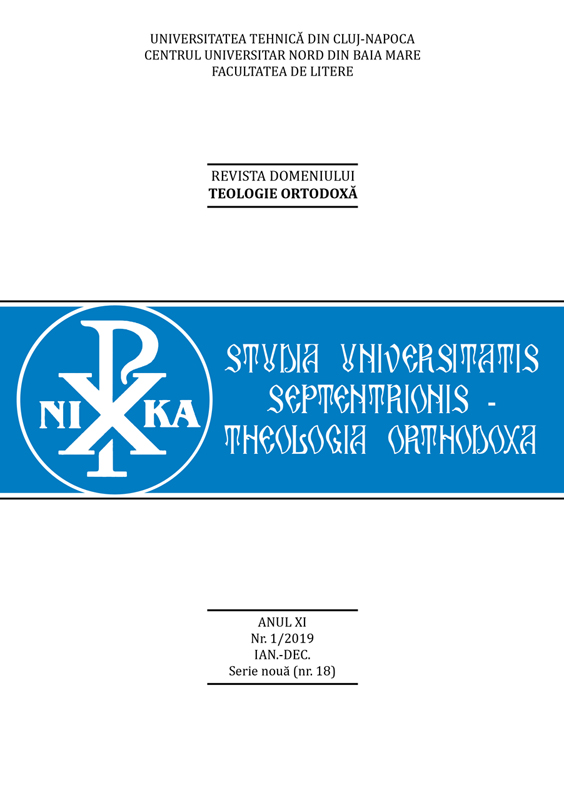
The Book of Leviticus used to be the first book that Jewish children studied in the synagogue, but in the modern Church, it tends to be the last part of the Bible anyone looks at seriously. Unfortunately, this book is one of those of the Old Testament that are usually not read much, even if it consists almost entirely of direct speeches of God. It is important to remember that the moral law of the Old Testament obliges Christians too. In case of a person commits trespass and sins unintentionally in regard to the holy things of the Lord (Lv. 4:14-16) the offering requires also restitution, to pay back what was lost, plus twenty percent. When we look at the sacrifices of the Old Testament, we know they are types, or symbolic representation of the Perfect Sacrifice of Jesus Christ. The ram, the trespass offering, remind Jewish the image of Abraham who wants to sacrifice Isaac, for Christians the trespass offering is a type of Christ. Applying the Christian teachings in daily life, that is, practicing the virtues as a way of life, the Christian manages to bring, spiritually, the sacrifice for trespass.
More...
The paper traces the main sacramental features of the episode of the Cana wedding, from the fourth Gospel. This passage is the first 'sign' among the ones placed by John in his Gospel. It reveals that Jesus' hour 'has not yet come'. All the signs have two main effects: for the disciples, they reflect God's glory and for the jew leaders they build up the decision to deny and reject Jesus and to put him to death. Ultimately, Jesus' death will be the hour of his wedding, where the sacramental wine will be replaced by his own blood. This is the first sacramental dimension of the episode of Cana, which announces the wedding between Israel/the Church and God/Jesus. The second sacramental dimension refers to the Baptism, which marks the transition from a secular life to a sacred one, as a foretaste of the messianic banquet. Finally, the episode of Cana is a sign for the Sacrament of Marriage in Christianity.
More...
For Christians, the Synod or the Ecumenical Council represents a meeting of bishops or the assembly of all those that debate the teachings of Christianity or universally valid pastoral orientations. The acknowledgement of the decisions taken by the Ecumenical synods or councils can be related to different church orientations. Thus, the Assyrians acknowledge the decisions taken by the first two ecumenical synods; the Chalcedonies acknowledge the decisions of the first three of them; the Lutherans acknowledge the decisions of the first four ecumenical councils, The Orthodox community acknowledges the first seven whereas the Catholics acknowledge twenty one synods or ecumenical councils. Among the positive reasons that stay behind the organization of such synodal works one can mention: the need to have a shorter and better generally understood faith formula; the need of the church to have a clear, worldwide organization and presentation once the status of tolerance was recognized through the Edict of the Mediolanum issued by Constantine the Great in 313.The negative reasons are the heresies and all the other Orthodox faith deviations which were the result of some wrong interpretations of the sacred texts. They were extremely dangerous for the church, as an institution, because their followers organized themselves in separate communities promoting a less Christian doctrine.
More...
Following the training of Romanian intellectuals to guide the Romanian culture, as well as the national struggle - political for the emancipation of their nation, the two Romanian Churches in Transylvania - Orthodox and United - sponsored both "folk" (elementary) and middle (high school) schools. The greatest achievements achieved by the Romanian Church in Transylvania, in the 19th century, were in the field of education and culture development in general, especially through the regeneration of the Romanian village school and the new spirit of the country's priests. The church, through its hierarchies and believers, has made every effort to obtain what it considers to belong to its nation, being receptive to the spirit of the time and convinced that its people could not achieve their political aspirations by despising the order of government since then, but at the same time he recognized the intensity of his national sentiment and endeavored to satisfy him in a manner appropriate to the time.
More...
Three decades went away since the Comunist regime has fallen. This brought to our country many virtues of the democraty society. Among these, a great victory was considered to be for the scholars and for the researchers, the freedom of movement, freedom of expresion and the unrestricted acces to archives and documents of the Comunist period. This is the reason why we consider it a happy choice that this year was dedicated ro the comemoration of two patriarchs: Nicodim Munteanu and Justin Moisescu. The two dreat hierarchs of the Romanian Orthodox Church are examples and models for what a monk, a priest, a Religion teacher and an hierarch should be like, should act like. They are examples for their hard administrative work, for their culture and fidelity to our Church and Country, so that the Church and the country live for the glory of God and for the joy of its people.
More...
In this study, it is considered the presentation of collections of church songs that appeared in Transylvania during the period when the priest Dimitrie Cunțanu was a teacher in Sibiu. However, the emphasis will be placed on the church songs in the Maramures area, on the monasteries and theological schools where the specific church song was taught. linear, composed by the father Ivan Boksay to Uzhgorod 1906, where they use the Karpatato-Russian songs. The presence in Maramures and Satmar of this variant of church singing, speaks of the spiritual connections that the inhabitants of these lands had with their brothers in faith in Transcarpathia. We could say, without fear of error, that these songs represent living documents, kept in the memory of many generations, about the church history of this region.
More...
Looking at the mode of sin manifestation, from the temptation phase to the fulfillment of it, it is carried out under a certain scheme: the enemy of man puts in man minds a certain will, which can be defined as a mistake. This mistake, which is a theoretical aspect known to man, yet unfulfilled in a concrete deed, turns into a vice that means a repetitive thought of the sins which will be done. The mind's concern over this vice provokes an extortion over the will of man, causing him to commit sin.
More...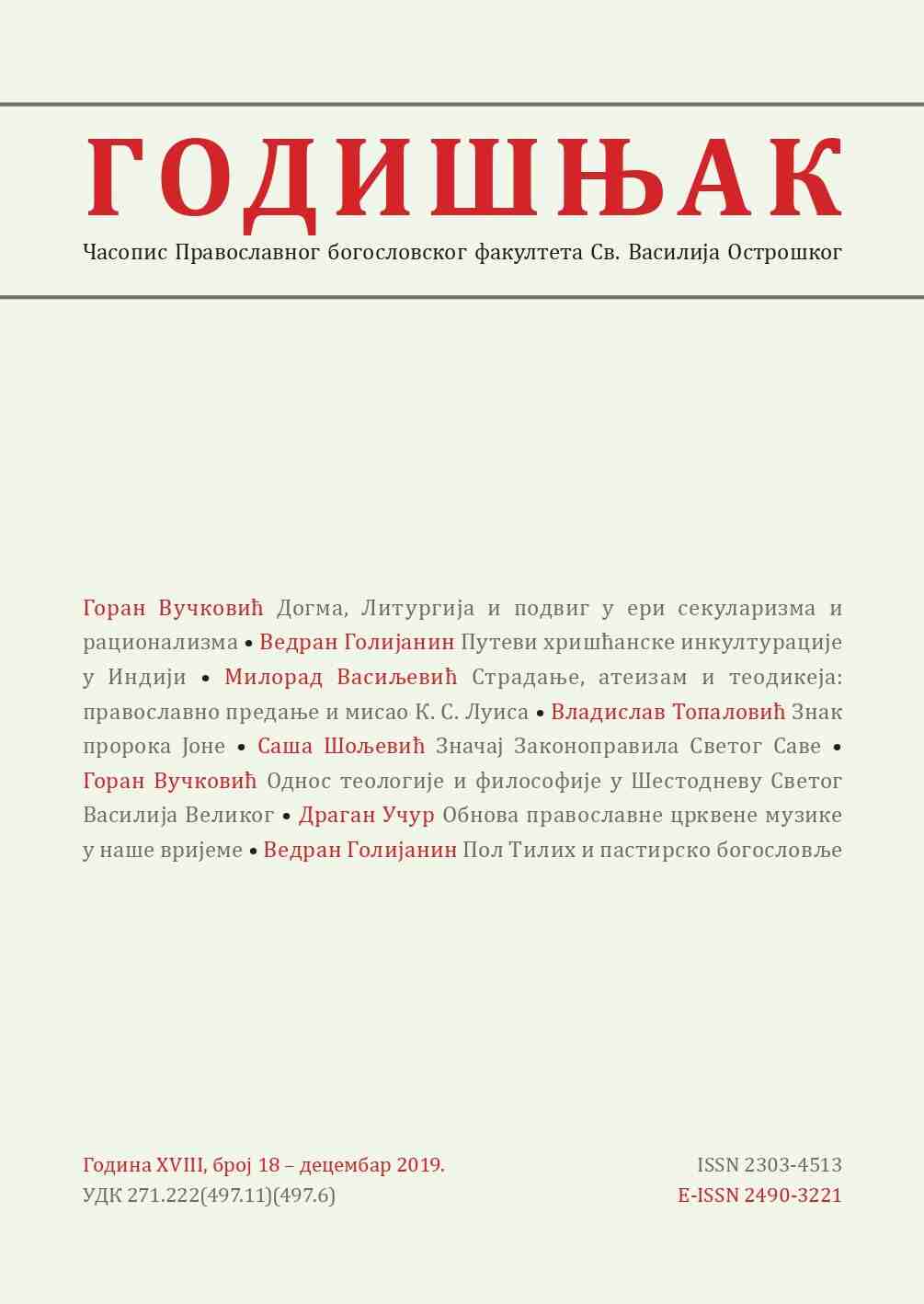
Saint Sava’s Zakonopravilo is a collection of secular and ecclesial laws that gave Serbian people a specific Christian view of Church, state, and society. Saint Sava has understood the importance of the law for organization of Church and people, because Church does not signify exclusively the communion of human beings with God, but also the communion of human beings among themselves. Saint Sava insisted that all who want to live in accordance with Zakonopravilo should cleanse themselves from vanity, hatred, and evil by the means of prayer and repentance. A nation possesses true values only if it lives a Christian life and if it incorporates Christian values in its history. Zakonopravilo does not contain legal collections that insist on universal authority of both Byzantine Emperor and Ecumenical Patriarch. As the matter of fact, Zakonopravilo is a result of original codification of Roman-Byzantine law. Goal of Church canons is to lead the members of the Church on the way of deification and salvation, while ecclesial punishments have pedagogical goals, and that is repentance and reintegration of a believer back into the Church life. Thanks to the Zakonopravilo, Roman-Byzantine law has become an important part of the life of people. The state was very early understood as a communion of all the faithful, as a mystical body ruled by the King and Archbishop. In the Nemanjić domain the symphony of Church and state was realized more fully than in Byzantium, for there was no caesaropapism; the domains of ruler and Church authority were clearly separated.
More...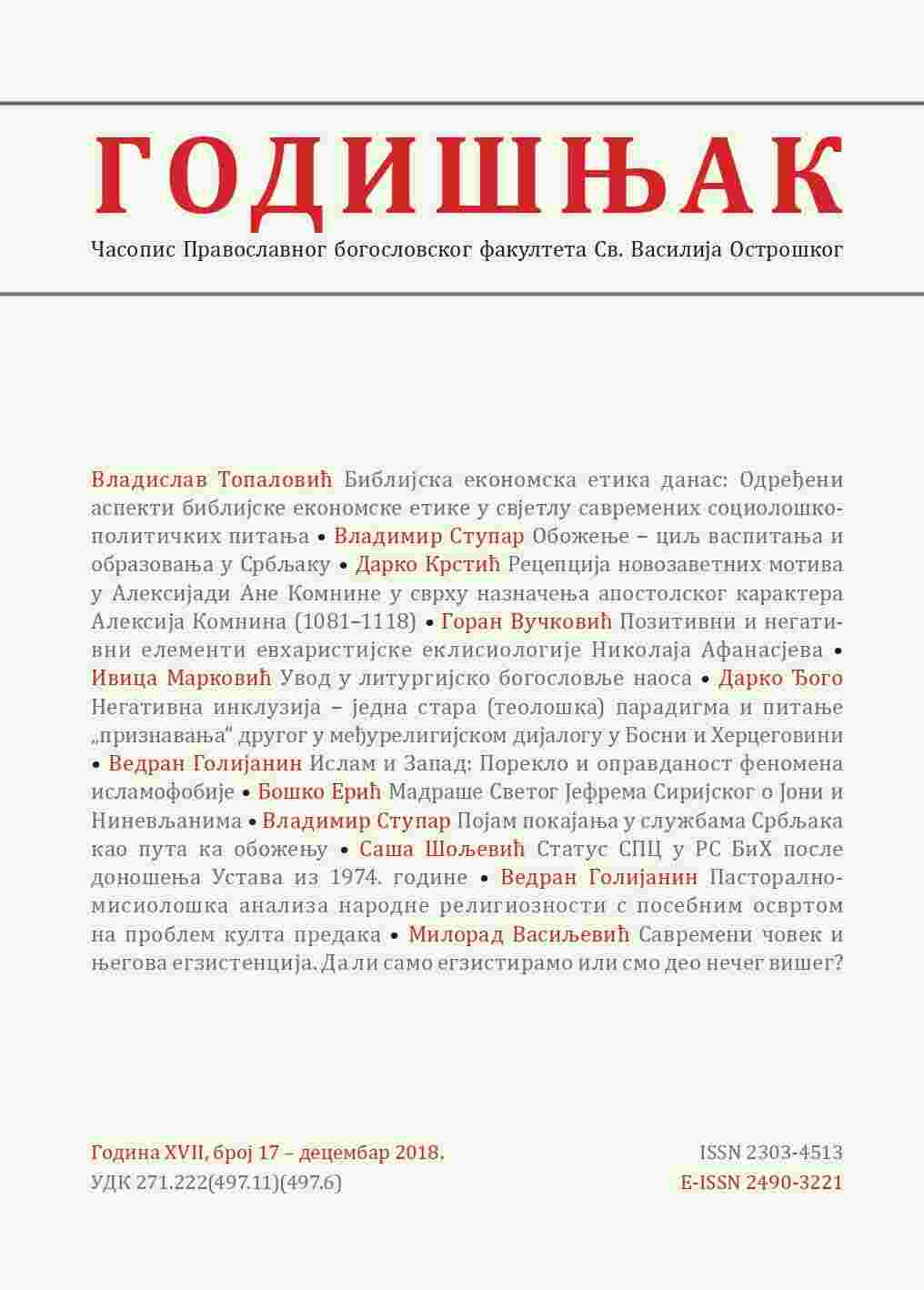
Eucharist ecclesiology of Nicholas Afanasiev is one of the most important contributions to Orthodox ecclesiology in 20th century. Although many positive elements in this theological concept are already recognized, there are still doubts and negative remarks regarding his Eucharist ecclesiology, notable for its identification of Church and Eucharist, i.e. the identification of local ecclesial community with the Church of God. Nevertheless, the review of the entire Afanasiev’s textual corpus leads us to conclude that the critiques of his ecclesiology are exaggerated, while many positive elements were overshadowed by those same critiques. The greatest and most famous critic of Eucharist ecclesiology is John Zizioulas, although his ecclesiology reaches same conclusions as that of Afanasiev. This paper is an attempt to point at both negative and positive elements of Eucharist ecclesiology in the context of Zizioulas’ critique.
More...
Када сагледавамо савременог човека може се рећи да смо сведоци све веће пасивности у промишљању о нечему што се назива живот...
More...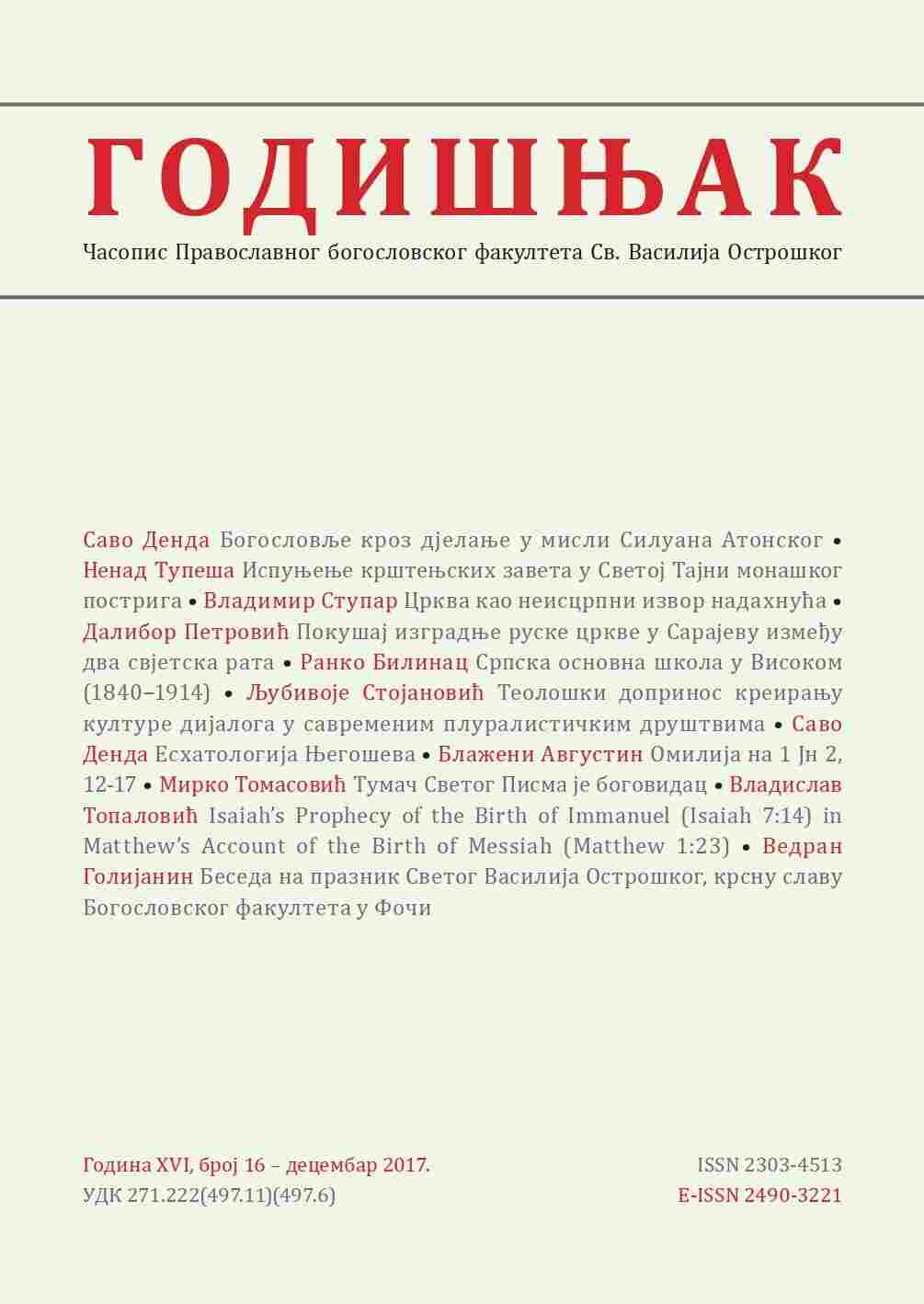
Theology is not a technology but a theology of the word. There are those who are dealing with the technology of the word, and those who are, throughout the active life, dealing with the very essence of theology. Elder Silouan is witnessing the Orthodox tradition of truth that is summarized in one sentence – act in order to know. If there is no action, than there is no knowing, and, therefore, there is no theology. Without action, there is no participation, and participation is possible only through knowing; without it, theology becomes and remains the technology of the word.
More...
The culture of dialogue is an important process and a great challenge for practical theology, especially in our post-conflict societies. Reconciliation is possible only when responsibility and optimism overcome pessimism, anarchy, and nihilism. It is important to recognize and face religious nationalism that creates identity of resistance, while encouraging the culture of peace that creates the identity of salvation.
More...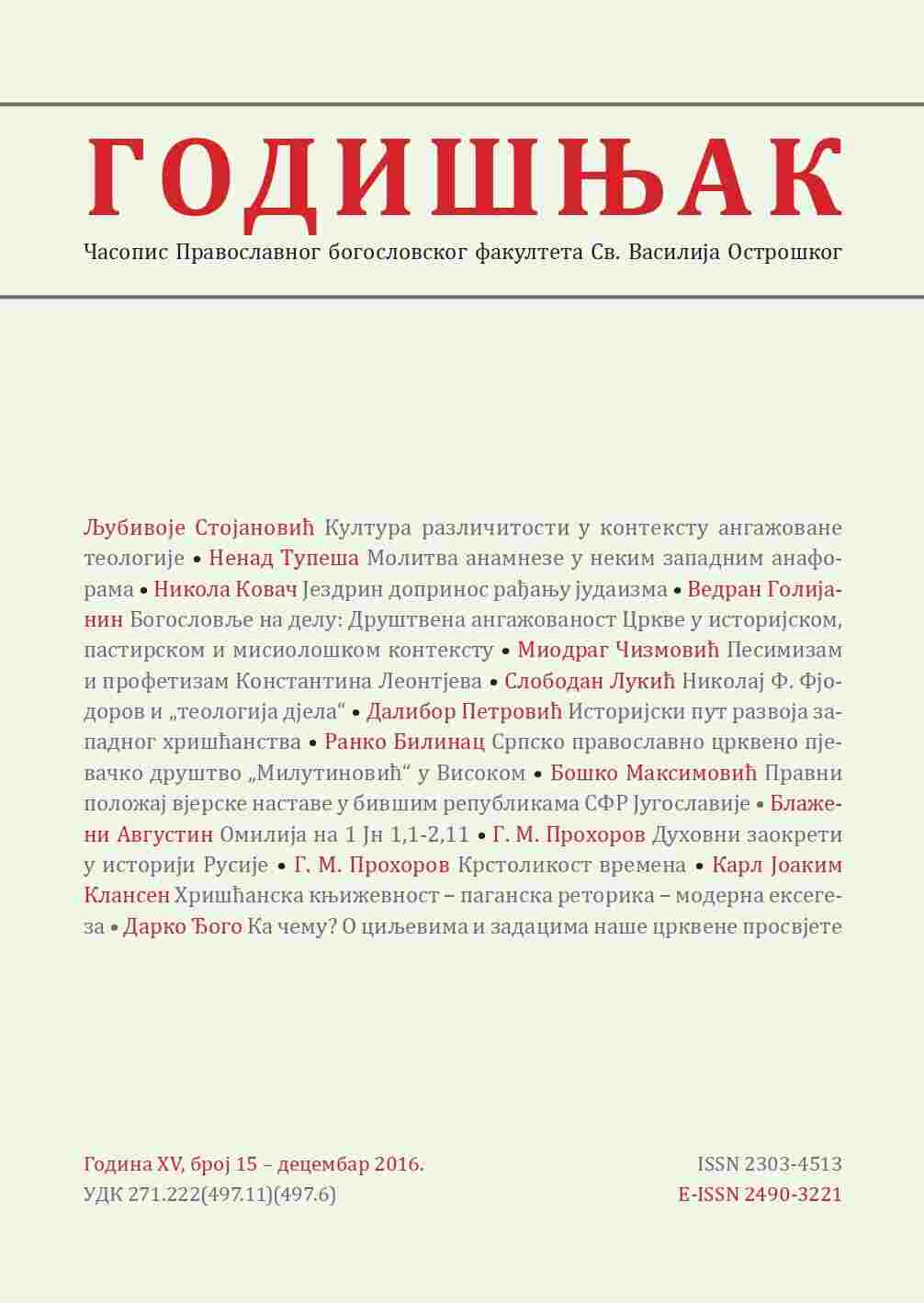
Leontyev insists that the end of the world is inevitable. The history must end, while the solution of historical meaning is meta-historical. According to Leontyev, Christ has never promised equality or justice on Earth; on the contrary, He often emphasized that, by the end of the history, evil will grow and human hearts will become cold. Leontyev also insists that the ideas of progress and endless perfecting, as well as postulates of French Revolution (brotherhood and equality), are false and vague. Dark future awaits Europe, if it is based on these demagogical platitudes. Leontyev advocates for the idea of healthy conservative attitude that can solely preserve the values of the past. The only meaning of life is salvation of one’s own soul, as Leontyev emphasized. However, before the end of history, Russia will enter the period of dominance and renaissance.
More...
In this paper, the author presents basic philosophical ideas of N. Fyodorov with special emphasis on the central idea – the idea of universal resurrection. Fyodorov advocated eccentric views on the resurrection of dead ancestors through joint venture of all people and with the help of science and technology. Although Fyodorov’s main inspiration came from Christian good news of Resurrection, he had parted ways with Christian tradition by emphasizing conditionality of Resurrection on men’s common task.
More...
У делима Дионисија Ареопагита, који од свих богослова заслужује највише дивљења, говори се о положају вечности над садашњошћу...
More...
Постоји важан закон на који желим да укажем, који и откривам тим указивањем: какав год придавали смисао својој садашњости, људи је увек повезују с другим временима, с овим или оним другим временом...
More...